#also this book is from 1890
Explore tagged Tumblr posts
Text
Thinking (once again) about how my ex would get mildly irritated and/or dismissive of my book collecting, and now dog boy is here telling me I gotta get this old ass book that came into our work, and saying it would be sick to read at my place
#im slowly developing better taste and he is teaching me to raise my standards#also this book is from 1890#its not an animal book; its a shakespeare book; but like EIGHTEEN NINETY YO#nabbing it at my lunch#also i doodled lil dogs on the stickers i put on our energy drinks this morning and he said i did good with them#and he likes them :3#happy#v happy#also slept well last night for the first time in ???????? uncertain
6 notes
·
View notes
Text
honours thesis project got me listening to church hymns on spotify at 1am
#had to go look up a recording of how firm a foundation so i could confirm that the book i read was not full of shit#when it said that's the basis for the melody of poor ellen smith#verdict: it is definitely the same melody or at least very close so yes i'm sure he was right that that's what the melody originally was#although some more recent versions (kossoy sisters; kingston trio) speed it up considerably when they're doing poor ellen smith#<- i realize i said 'more recent' and then cited two versions from over 60 years ago#keep in mind i was also working with field recordings from the 1930s and newspaper clippings with transcribed lyrics from the 1890s#soapbox#murderballadology
8 notes
·
View notes
Text

The Ducal Wittelsbach family and their relatives, early 1890s. From left to right, standing: Karl Theodor, Duke in Bavaria, Duchess Elisabeth in Bavaria, Archduchess Elisabeth Amalie of Austria, Duchess Sophie Adelheid in Bavaria, Archduchess Maria Annunziata of Austria, Princess Maria Immacolata of Bourbon-Two Sicilies, Duchess Marie Gabrielle in Bavaria.
Sitting: Archduchess Maria Teresa of Austria (née Infanta of Portugal), King Francesco II of the Two Sicilies, Queen Marie Sophie of the Two Sicilies (née Duchess in Bavaria)
Via As Infantas de Bragança e a Sua Descendência - História das Filhas de D. Miguel by Dativo Salvia Ocaña
#look what i found completely by chance! the quality isn't very good because it's from the book's preview#francesco died in december of 1894 so the picture is from before that date#but definetly 1890s because. puff sleeves#(also the author misidentifies maria teresa as her sister maria josé and maria annunziata as mathilde countess of trani)#karl theodor duke in bavaria#queen elisabeth of the belgians#elisabeth amalie of austria princess of liechtenstein#sophie in bavaria countess of toerring jettenbach#archduchess maria annunziata of austria#maria immacolata of bourbon-two sicilies princess of saxony#marie gabrielle in bavaria princess of bavaria#maria teresa of braganza archduchess of austria#francesco ii of the two sicilies#queen marie sophie of the two sicilies#house of wittelsbach#house of bourbon two sicilies#house of braganza
28 notes
·
View notes
Text
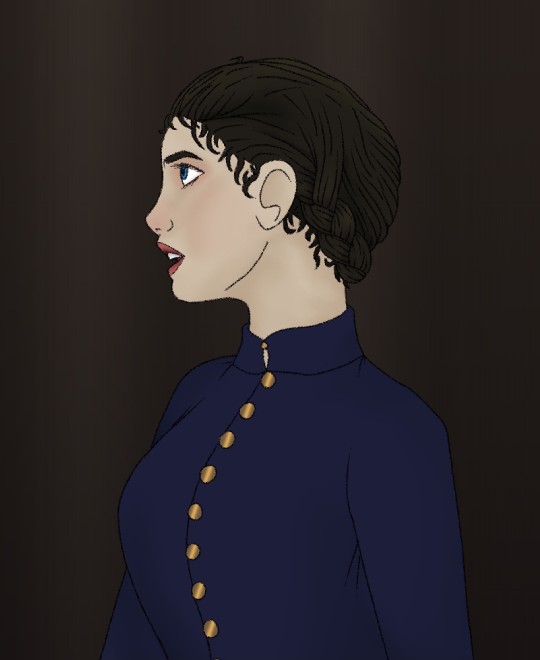
She did not shrink back, though the pupils of her eyes dilated. Was it the wildest thing in the world which happened to her—or was it not? Without warning—the sudden rush of a thought, immense and strange, swept over her body and soul and possessed her—so possessed her that it changed her pallor to white flame. It was actually Anstruthers who shrank back a shade because, for the moment, she looked so near unearthly.
“I am not afraid of you,” she said, in a clear, unshaken voice. “I am not afraid. Something is near me which will stand between us—something which DIED to-day.”
---
behold: my artistic contribution to the small but enthusiastic You Should Totally Read The Shuttle (1907) By Frances Hodgson Burnett campaign
#I was gonna draw the full scene with Nigel too but then I remembered that I actually do not know what he looks like#so I just did betty#fun fact!! I based Betty's riding habit off of pictures of an actual extant riding habit on the Met museum website!#(though idk if hers would be fancier or not)#oh an her hairstyle is based off of an illustration of several women on horseback in that time so that's semi-accurate too!#I didn't give her the hat/veil that she would have been wearing because I couldn't get that to look right in the drawing#but hey maybe just it fell off when she fell off her horse or something#the shuttle#jessica's art#oh yeah also I spent like 20 minutes examining the book for details to clue me in to when it took place so I could be accurate lol#I know it was written in 1907 but some parts of it made me wonder if it was set before then so i did the math#judging from the references to nigel being raised in the early victorian era my best guess is probably between 1870 and 1890!
25 notes
·
View notes
Text
this morning i witnessed a post on here that made me clench my fist so hard... is that what y'all always feel like when you see a poor take???
#i resisted the urge to hate the hater back#it was so needlessly unkind#some guy on reddit posted a pic of Tik-Tok (from Return to Oz (1985) the adaptation of Ozma of Oz (1906))#and yea he said boomer shit like “nOw ThIs Is ThE TiKtOk wE hAd WhEn We WeRe YoUnG”#but the tumblrina just pulled up Ozma of Oz sayin “ppl born in 1890/1900 turn 40 this year i didn't know” like BRO#YOU PUT RETURN TO OZ IN YO TAG WHY ARE YOU PULLING UP OZMA OF OZ#YES PEOPLE BORN BEFORE 1985 TURN 40 WELL DONE ON THAT ONE#ALSO WHAT. WHY– HUH??? BOOKS HAVE PERMANENCE YKNOW. YOU DON'T HAVE TO BE THERE THE YEAR IT WAS PUBLISHED TO ENJOY IT#HE COULD BE TURNING 20 FOR ALL THAT MATTER#anyways p sure the tumblrina was trying to do a funnie but . dude. that was just picking on a guy that too prolly pulled a funnie#augh#maybe i am over reacting tho ... sigh#rambling#also i did assume the redditors pronouns but i can't be bothered to edit all them tags im sorry random person i don't know
4 notes
·
View notes
Text

It’s Dear Santa time again!
Every year since 2010, I have spent the month of December posting children's Dear Santa letters.
Publishing letters to Santa in the newspaper first became widely popular in the late-1890s, though scattered newspapers did so as early as the mid-1880s. I believe this sudden explosion in popularity was at least partially the result of the famed "Yes, Virginia, there is a Santa Clause" editorial which was published in The New York Sun in September of 1897.
In large cities Dear Santa letters often acted as a method of getting needed clothing and supplies to impoverished children when parents might be ashamed to ask for charity. Subscribers to the newspaper could choose a child’s letter and provide the items they asked for. The most common requests were shoes and coats.
Sometimes newspapers offered prizes for the best letter (which I suspect often acted as another clandestine form of charity as the winners were often letters asking for basic clothing and school supplies.) Though these prizes could range from the ordinary (a sled or a doll) to the extravagant (a $20 gold piece or a live pony.)
Often local stores would enter children in a drawing if they mentioned the store in their letter - which on occasion would result in children hilariously name-dropping every store in town just in case.
Writing Dear Santa letters was also commonly an activity done at school, often following some rough form letter. These letters are fairly easy to spot as they often hype up what a good student the child was and include effusive praise for their teacher (who would likely see the letter before it was sent.)
So why have I spent hundreds of hours of my life over the last decade reading tens of thousands of these letters?
Children's voices are largely absent from the historical record.
Dear Santa letters offer an extremely rare opportunity to see history unfold through children's eyes - in their own (often creatively spelled) words.
1914′s “Remember the children in Belgium” becomes 1918′s “Please visit my brother in France”.
During the Great Depression the very common phrase “I know you’re poor this year too Santa” gives a glimpse into parents' attempts to explain to their children why they might not be getting as much this year.
1939′s “Be careful flying over Europe” becomes 1945′s “Since the war is over you’re making bb-guns again right?”
Requests for toy flying machines become aeroplanes become fighter jets become space shuttles.
Dolls and wagons become Shirley Temple merchandise and Erector Sets become Barbies and Star Wars action figures.
But through all these changes one thing remains clear throughout 130+ years of letters to Santa, despite the rapidly changing world around them - children have always been children.
I hope you enjoy these letters as much as I do! (All decade+ of posts are tagged “Dear Santa” if you’d like to see more than just this year’s selection.)
I wish you all a wonderful holiday season! I hope you can delight in whatever brings you joy, be that family, friends, food or just curling up with a hot cocoa and a good book.
But whatever you do, please don't forget the true meaning of the season - feeling awful sorry for Patti.
Hapy Holadays and Marry Crimes!
445 notes
·
View notes
Text
the gut punch of having been a Twilight fan in high school when the hype was at its zenith, without reading SMeyer interviews or following her on social media, and then seeing her inspiration for, or personal interpretation of, certain outfit descriptions years later
like
I have just learned that this was supposed to be Alice's prom dress in book one?

A. that is hideous; what the hell
B. to a PROM. in 2008. when you're VAMPIRES IN HIDING TRYING TO BE INCONSPICUOUS
(I mean, I guess the excuse is that the Cullens are terrible at laying low anyway? but still. That doesn't make it any less Uggo, or more appropriate for an apparent high school sophomore)
and the movies already dealt me psychological damage since SMeyer signed off on the designs, revealing that her idea of an "Anne of Green Gables" wedding dress was this:

the timeline of the Anne books is a little funky, but I've always assumed they started in the late 1880s-early 1890s given the combination of Much Ado about Sleeve Puffs but also Anne somehow being old enough to have kids fighting in WWI later. so here is an early 1890s bridal fashion plate:

La Mode Illustree 1892
and her engagement ring, which I recall being described as diamonds in a net of white gold, or filigree, or something similar. not um. a cheese grater:

(it was supposedly his biological mother's engagement ring, which means it's from around the turn of the 20th century. I've worked with a lot of antique jewelry in my time, and I've never seen a Victwardian piece like that. if she was picturing a diamond cluster ring, they still had less of the cheese grater about them)
(plus, again...It Is Ugly)
I no longer have a dog in this fight, since I'm not in the fandom anymore. but sometimes I am reminded of this Expectation Vs. Reality situation all over again
#long post#twilight#Does Stephanie Meyer Know What The Late Victorian/Edwardian Eras Looked Like: the post#(also does she realize that the era Edward died in did not look 'Anne of Green Gables' as she's probably picturing it)#(ie the look of the first book)#(when he died in 1918 which was rapidly hurtling towards 1920s fashion already)
339 notes
·
View notes
Text
Thread: Sylvia Feketekuty on the influences of Emmrich and the Mourn Watch
The rest of this post is under a cut due to length and possible spoilers.
Sylvia Feketekuty: "I think I've gotten to most people’s questions, and I promised I'd talk about influences on Emmrich and the Mourn Watch before wrapping this up. So here we go! It took me while to figure out Emmrich's character voice. I'm happy with where I landed, but he was a tough one. A few books helped me out. MR James' Collected Ghost Stories (1890-1930) My favourite ghost stories of all time. James excels at building dread, at writing people finding strange things in books, or around the corner, or in the old lane at night."

"He was also an antiquarian and a scholar at Cambridge. I wanted Emmrich and the Watchers to feel formal, but not like they were from another epoch. James’ language, polished by a rich academic career, was an excellent benchmark for 'older, but not ancient'. E.g.: if using contractions was appropriate for James' time, it was appropriate for Emmrich. It freed me up, mentally speaking, to deploy them whenever they improved cadence or flow. Thomas Ligotti's Songs of a Dead Dreamer Fellow Ligotti fans may already be thinking Emmrich doesn't really share the philosophy underpinning Ligotti's work, and they’re right. However!"

"Songs of a Dead Dreamer is filled with fantastical imagery that’s a bit lusher than that found in Ligotti's later works. It was really good at bringing to mind the kind of moody, expansive dreamscapes I think our necromancer mentally occupies. It’s from a different book (Noctuary), but Ligotti’s “The Spectral Estate” also merits a mention. If you plunked it down in front of Emmrich to read, he’d know exactly what it was on about. The Romantic poets (or any poetry on similar themes: overpowering swells of emotion, the grandeur and awe of nature, love and loss and grief.) Palgrave's Golden Treasury was usually in reach."

"If I was in a jam, or psyching myself up for a scene, sometimes I’d read a few poems to get into the proper head space. Or just for the pleasure of it. Poems are great! Please take a link to Shelley's "A Dream of the Unknown", one of my favourites. [link] I also read a few books by morticians and funerary directors. A friend lent me Smoke Gets in your Eyes and From Here to Eternity by Caitlin Doughty (probably the most famous mortician on the internet?) I also checked out Nine Years Under: Coming of Age in an Inner-city Funeral Home by Sheri Booker."

"These books were full of lessons about how people react to death, how different cultures treat it, how anger and grieving express differently but come from the same wellspring. Very humane looks at how we deal with loss and other people. Moving on to non-books: My First Cadaver, a podcast of stories from medical students and medical professionals."

"I listened to a few episodes My First Cadaver, and there were some incredible tales in there. Gross (I could never be a doctor) but incredible. And I was struck by was how much students working on donated cadavers got attached to them. I can’t remember if it was in MFC or not, but there was one story about a medical student introducing his date to the cadaver he was working on like she was a beloved aunt. It was very sweet! Peter Cushing in Horror of Dracula (1958) and The Curse of Frankenstein (1957) These films are filled with handsome costumes, ominous sets, and the oversized passions I associate with gothic melodrama. Cushing's perfect in them."

"His portrayals of Van Helsing and Baron Frankenstein are brisk, determined, obsessive, and brimming with energy; they’re scholars who are experts in their field, yet still men of action. They felt like natural touchstones for a professor suddenly called to grand adventure. I also ended up reading Cushing's memoirs. In a bit of strange synchronicity, there were similarities between his life and traits I'd already decided to give Emmrich. Cushing came from a working-class family, had an intense phobia (his was of the dark), was vegetarian, and so on. I'd had no idea."
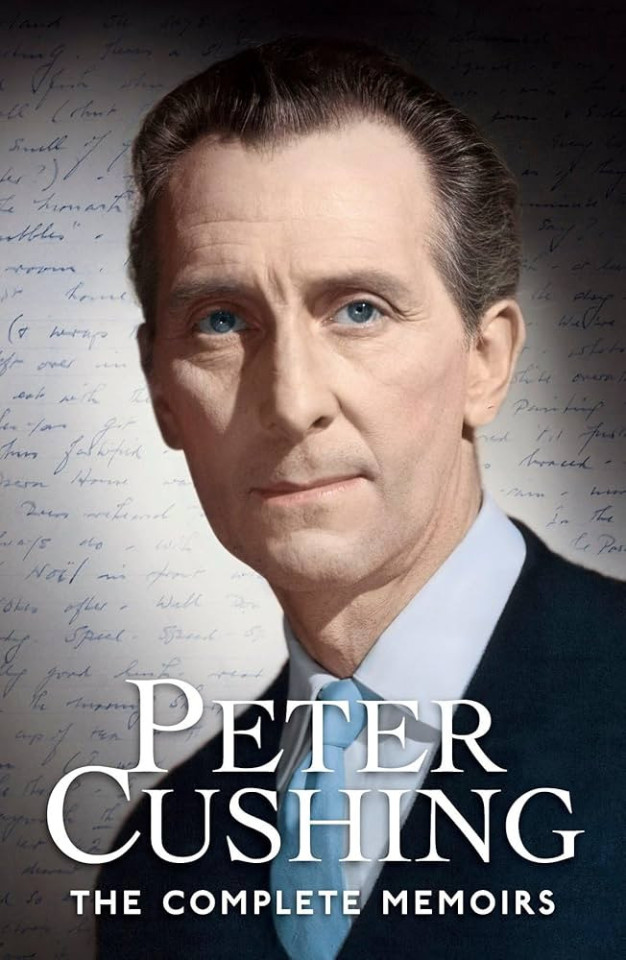
"(Humans tend to pattern-match, but it was a little eerie.) A side note: I've seen people speculate Emmrich was based off of Vincent Price. There’s a bit of the good Mr. Price in there, but Cushing got to play more heroic roles than he did. He felt more right to me. A second side note: did you know Vincent Price was a gourmand who loved to entertain? He and his wife Mary put out a beautiful cooking book, A Treasury of Great Recipes, filled with warm and charming commentary. If you're interested in that kind thing, highly recommended!"

"One influence when I was pitching the Memorial Gardens to the rest of the team was Swan Point cemetery in Rhode Island. It's where Lovecraft was buried, and like many a Weird Tales nerd before me, I was curious and wanted to see it."
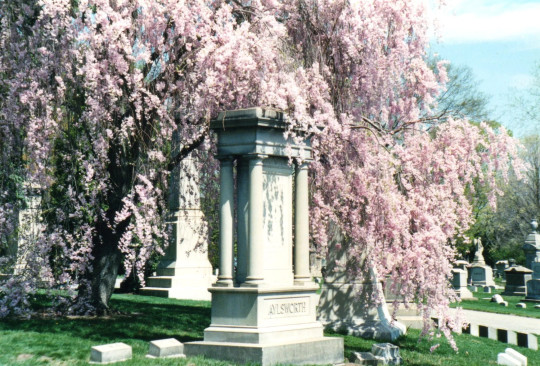
"I wasn't prepared for was how lush the plants and flowers were, and how beautifully landscaped everything there is. Swan Point is a historical burial place, and also a carefully tended garden and arboretum. It stunned me. I'd never been in a cemetery like it. Emmrich complains about Hezenkoss making him play complicated wargames when they were students, and that one in particular had three separate rulebooks."

"I've seen people guess whether I was referencing D&D or Warhammer 40K. D&D was formative, and I know a frankly embarrassing amount about WH40K at this point (No regrets. Necrons and Admech 4-ever.*) But the origin is even sillier. *Why yes, Mechanicus 2 IS my most anticipated upcoming game. I used to own the first edition of a board game called Mansions of Madness, and was supposed to learn the rules so I could lead my friends through it. But come the day, I’d procrastinated, and was running short on time."

"Fantasy Flight's previous game in the same vein was Arkham Horror, and AH is not a simple game. But I remember being hopeful, as I peeled the shrinkwrap off, that maybe MoM would be easier to learn than AH. Have streamlined rules, or fewer things to remember. Then the top popped off, and three separate rulebooks fell out and slithered to the floor. (The DAV game’s not meant to be MoM, but the absurdity of that moment stuck with me.) (It's not the game's fault, by any means, that I was unprepared, and the session went as well as it could have with me flipping through the books going "Okay wait...hold on...I think that was here...no, wait.") The Nevarran hazelnut torte recipe is actually a family recipe from my grandmother, on my father's side. I’m beyond delighted people have actually made it. (Our recipe uses metric measurements, but the DA style guide uses imperial, so I was worried about the conversion. Looks like it went okay.)"

"On my mother's side of the family: my grandmother cooked and cleaned for a living, and my grandfather was a butcher. He passed away before I was born, and my grandmother when I was very young. So I gave Emmrich’s parents those professions as a little nod to the grandmother I only knew very little, and the grandfather I never met at all. I would’ve liked time with them both. And to end on a lighter note, "Ever thought of becoming a hat person?" is an extremely oblique reference to a line spoken to one of gaming's greatest characters: Murray, the demon skull from Curse of Monkey Island. (Curse is the first Monkey Island game I ever played, and therefore my favourite.)"

"Small bonus: here’s the music I listened to most while working on Emmrich and the Watchers. Some of it probably only makes sense to me, some of it seems thematically obvious. (I don’t have Spotify so best I can do is an itunes screenshot.)"

"Not on the screenshot because I changed PCs halfway through, but I also listened to a lot of music from Cryo Chamber, a great dark ambient label. [link] And their sister label, Cryo Crypt, which does "Dark Fantasy Dungeon Synth." [link] And also Allicorn IS on the screenshot but I think I've listened to his stuff on every game I've worked on by now. [link]"
[thread source link]
---
Bonus: follow-up comments and exchanges -
User: "I KNEW the torte was somebody’s family recipe!!" // Sylvia: "My only regret is that the icing was originally a stove-boiled icing made with eggs and chocolate and butter emulsified together. I couldn't get it working, however, these past few years. I think we lost some crucial part of the steps when trying to write out a clean copy. So I went with ganache for the game, because I didn't want to print something that didn't work, and I've used ganache myself. It's good! But I'm going to try to replicate the original again one day." [source, two] // User: "I noticed that sometimes, ingredients doesn't react the way they used to and part of that is probably due to some "industrial" changes in the recipe for ingredients like chocolate or butter to cut the cost of making them, imho. It's sad because it means we lost a very specific way to do things..." // Sylvia: "Yeah, that was the first thing a friend who bakes a lot suggested. I wonder if I was a victim of "Buttergate" when Canadian cows were being fed so much palm oil butter was harder to spread as a result. After a long search, I found a local place that makes butter that actually tastes good, which is an incredibly sad sentence to have to type out." [source, two]
Sylvia, re: Vincent Price being a gourmand and his cooking book: "It's extremely cool. My library had a copy and I remember it being pretty big, too." [source]
User: "I was following this thread and I'm delighted about all of these facts and information. Thank you for sharing!" // Sylvia: "Aw thank you! And thanks for reading, it was nice to unpack all the stuff kicking around my mental attic." [source]
User, re: MFC: "Sorry to post again but this one got me- my mom is a doc, and i remember her telling me stories of the cadaver she worked on (evidence of different surgeries she had, the cancer she had, etc), and mom always ended her stories saying how thankful she was to her. It really does stick around." // Sylvia: "No need to apologize, I liked hearing about your mom's reaction! It's exactly what I kept hearing and reading about, a sense of reverence for the gift." [source]
Sylvia: ""The irony that I had to convert the measurements back to metric" Haha. I tried to get as close as I could. Here's the written down metric version of the cake batter. It's an older recipe so I had to try to guess what a "knife tip" ended up as." [source]

A user on the torte being a family recipe: "Oh my gosh 🥹 that makes it all even lovelier!" // Sylvia: "Thanks! I was really excited to share the family recipe, it's a bit of work but it's one of my favorites." [source]
A user under the post about MR James' Collected Ghost Stories: "So you're probably the one behind the mysterious bronze whistle, I take it?" // Sylvia: "Haha, guilty. Cameron Harris, our editor, helped me figure out a phonetic guide to the latin. (If it fails anywhere it's very likely my fault.)" [source]
User: "As an avid Emmrich lover & someone trying to write some Emmrich POVs in my Emrook fanfictions, I can not thank you ENOUGH for this wealth of info / music inspo to go off of" // Sylvia: "Thank you! (Seriously though some of those songs probably only make sense to me, they're not all thematically on point, but some are. Hope you enjoy!)" [source]
User: "As another "needs a million hours of droning ambient music to write" writer I appreciate these greatly" // Sylvia: "We both have good taste! 🎶" [source]
User: "Thank you for writing out this list!! Peter Cushing makes so much sense as an influence. I love the variety of media here, it gives me so much new stuff to check out!" // Sylvia: "Thank you for reading! If you do check out some of this stuff, hope you enjoy!" [source]
Sylvia: "thanks so much, and for reading the thread! It was fun to write." [source]
User: "Thank you for sharing these books!I was looking for a good ghost book" // Sylvia: "Thanks! Hope you enjoy James. "Oh, Whistle, and I'll Come to You, My Lad" was the first story of his I read and I'll never forget that experience." [source] // Sylvia: "I just love the mood James could create, so much." [source]
User: "ELECTRIC SIX MENTION" // Sylvia: "My greatest favorites, now and forever." [source]
Sylvia: "Please archive away, I am intent on deleting the account eventually but it'd be nice to know people could look this stuff up later if they're curious. (Future generations need to know which Atrium Carceri tracks I listened to!)" [source]
User: "Amongst many things, not the least of which is the gratitude and delight of having your fantastic insight into the writing process of Emmrich, my grandmother’s hazelnut torte is fantastically close to the Nevarran version which was a delightful discovery." // Sylvia: "Ah now nice. I assume she was also central/eastern European then? I suspect it was a popular recipe at a certain time." [source]
User: "As an ex-mortician turned game writer, this was a FASCINATING read!" // Sylvia: "Haha, I definitely took inspiration from morticians! (Thank you for checking it out, that thread got long)" [source]
User: "ATRIUM CARCERI - Such a perfect band for the Mourn Watch!" // Sylvia: "I stumbled on Atrium Carceri when I was a student, and there's happily so much dark ambient available now, but Simon Heath's particular vibe can't be beat." [source]
User: "Rockefeller Street is just like that, man. It's sticky." // Sylvia: "Yes! It's so good, it just hits a certain mood dead center." [source]
Sylvia: "Ginkys of BlueSky has created a Spotify list of the music I listened to when writing Emmrich and the Watchers! Almost everything's on there. Thank you Ginkys. (FYI: Not everything I listened to matches the MW vibe, sometimes it was just a song that got stuck in my head for a few weeks.) - [link]" [source]
User: "I appreciate Replay being on here so muuuuch" // Sylvia: "My favorite song on the album! Though 911 was also real solid." [source]
User: "Love that there's Lady Gaga" // Sylvia: "Friend just sent me Abracadabra, I'm excited for the Gothic Camp here." [source]
Sylvia, about the torte recipe: "If it's useful, here's the full thing in metric. WARNING: Last two times I tried this cooked icing, it failed. I'm not sure whether I miscopy a crucial step, or if changes to local butter were the culprit. Either way, proceed with caution. A ganache is way safer, and very similar." [source]
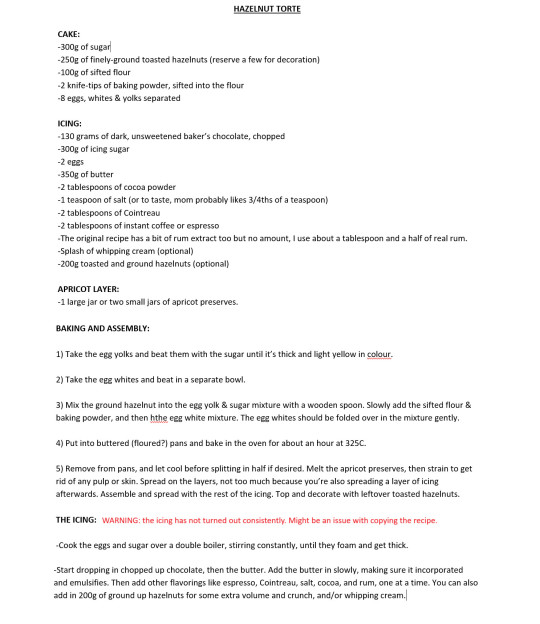
^ User: "Thank you! That's helpful. I haven't baked many cakes before so I'll do some research about icing/ganache before trying. Hopefully looking at local (Swedish) recipes will give me a hint of what to be careful with." // Sylvia: "Ganache is SUPER simple (you basically heat cream and pour it over chopped chocolate), so I lean even more towards recommending you go with that instead of the cooked icing. Hope you the baking." [source]
[thread source link]
#dragon age: the veilguard#dragon age the veilguard spoilers#dragon age: dreadwolf#dragon age 4#the dread wolf rises#da4#dragon age#bioware#video games#long post#longpost
274 notes
·
View notes
Text
Jewish folks of tumblr, I have a question for anyone who knows a lot about the history of Germany 1890-1920, specifically in the Apolda region, and Jewish last names.
I am interested primarily because two different sources (one being a gentile doberman person, and the other being a nonpracticing Jewish person) have informed me that the last name Mann and names ending with the syllable Mann were primarily of Jewish ethnicity within Germany.
This is interesting to me because the doberman breed comes from the name of the creator- a tax collector in Apolda named Karl Fredrich Louis Dobermann. He made the breed to protect him because he was getting attacked while performing his job.
This is also interesting to me because MULTIPLE doberman history books that I've read have stated the breed lore that despite Hitler's seize of control of the breed during his rise to power in Germany, many of the breed's founders who took over the care and legacy of the breed after Dobermann's death were adamantly anti-Nazi, voiced disagreement with Hitler's ideals, and moved rapidly to get as many of the dogs out of the country as possible to prevent him from using them. This is repeated in American historical accounts- that at some point this country had a higher number of dobermans than Germany, right before the war officially broke out, and that German breeders were exporting their dogs here en masse to prevent the breed from being destroyed by the ensuing chaos.
In modern days, the breed is infested with far right, Q-anon, and neonazi reactionaries here within the US, owing a lot of that to its German roots and use during the war as well as its reputation as a fierce police and military dog both in Germany and here in the US.
I think it would be very interesting indeed if the breed had Jewish or Jewish-adjacent origins that were erased by Hitler's destruction. We already know that Dobermann himself was extremely cagey about his personal life as well as what went into the breed. We also know that at least two of the three people he passed the torch to were vocally anti-Hitler, if the history books are to be believed. And we know that the doberman history itself has experienced many purges of information, missing journals and pedigrees, cobbled together on a "stop paying attention to this" and "oh it was lost in the war".
We also know that this was commonplace among Jewish and Jewish-friendly communities to scrub the evidence of the existence of Jewish people present in an area to prevent them from coming to further harm as the SS began to search for anyone they might have missed.
Dobermann was buried as a German and, to my knowledge, was registered on the census as a German. I'm wondering if there could be any connection to Jewish community whatsoever, or if it just so happened that the early doberman people were not Nazis, or if the breed history books have got this so very wrong.
This comes especially as I watch the German Shepherd community once again get rocked with the realization that their own breed founder was proudly pro-Hitler, writing about it in his journals and breeding theory, while the doberman community mostly has 🤷♂️🤷♂️🤷♂️ I guess he didn't write it down 🤷♂️🤷♂️🤷♂️ to compare.
Again, I just find that very interesting, as "oops I guess there's no records" are a fairly common tactic used by freedom fighters and abolitionists worldwide to protect a vulnerable population. And it seems like an interesting coincidence, if the rest has any real truth to it.
185 notes
·
View notes
Text
A few thoughts on The Gilded Age trailer
Putting it below a cut for images and also vague spoiler-y thoughts on the Season 3 trailer. Let's all speculate wildly to stay sane.
We know that George is in Arizona for (most? all of?) episode 1 and that Bertha has Gladys' portrait painted to prepare for the Duke's re-arrival in New York. It seems very likely that Ep 1 is winter of 1883, as evidenced by the snow ball fight promo images and the one of Marian in a fur-lined jacket.
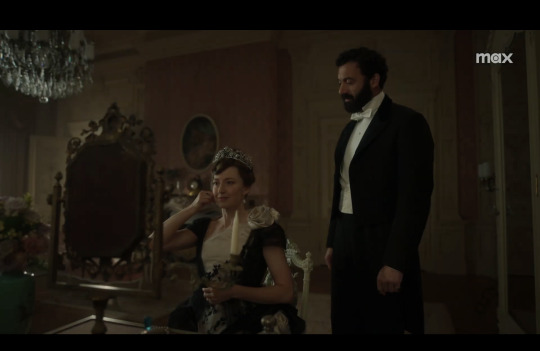
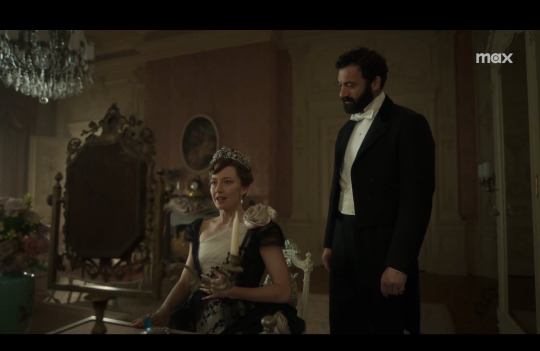
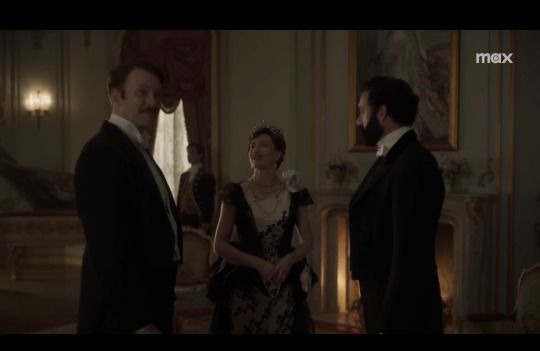
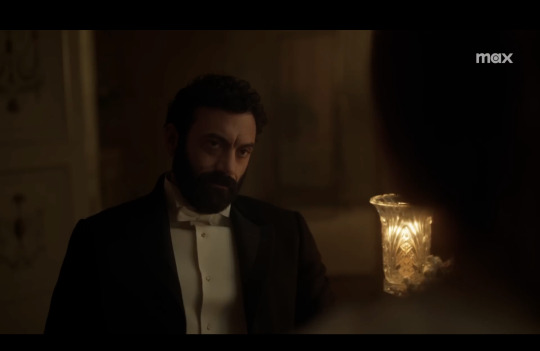
Here's my guess at an episode 2 sequence with the "set your mind to it" and "children's marriage" lines from George. I'm guessing George comes back from Arizona in time for the Duke's arrival and this is the welcome back dinner, with George at the end of it interrogating Bertha once the dinner is over. It seems as though she gets him on her side of things (at least temporarily), and that later (same ep? ep 3?) we get this sequence.
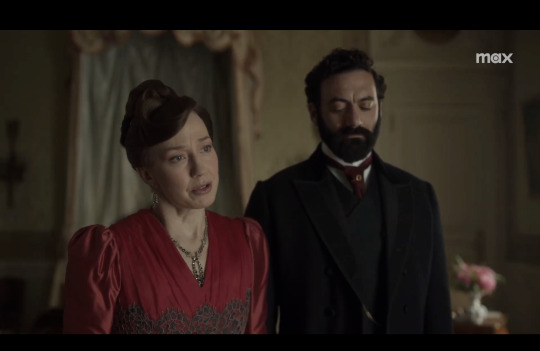

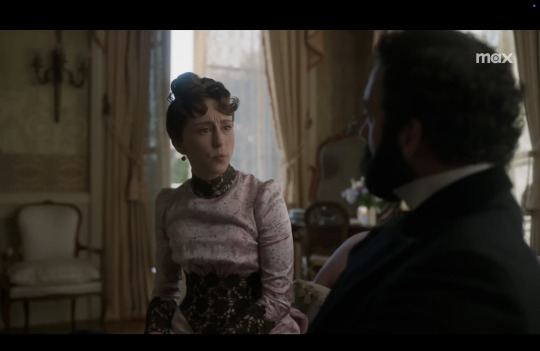
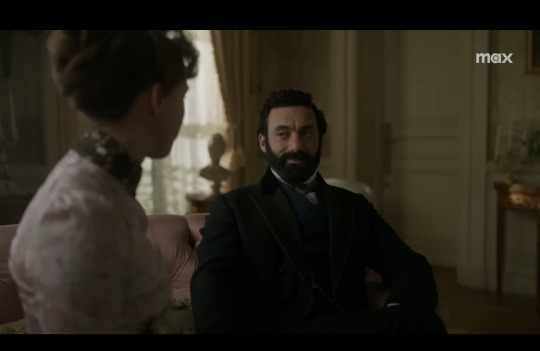

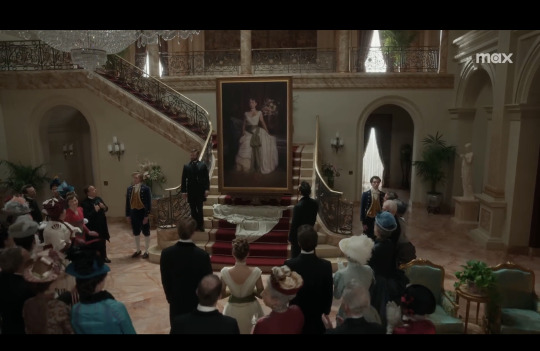
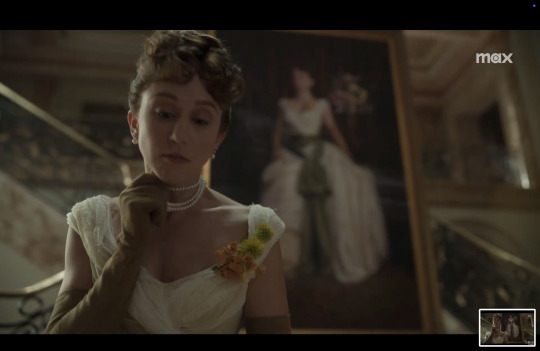
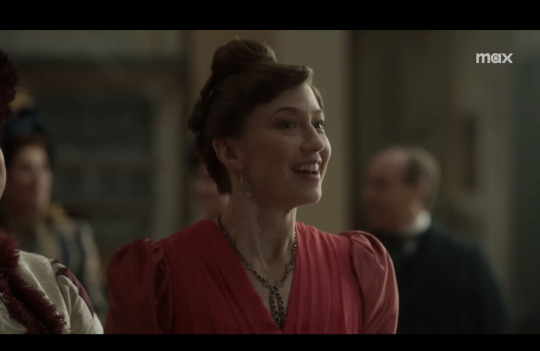
These frames are from promo images, the teaser and the trailer, here listed in my approximated order. It appears that Bertha prepares Gladys for the idea of the Duke proposing, Gladys pushes back against George, but George then holds his ground (maybe something like, "your mother thinks it's best/I urge you to hear out the duke and consider him") and then Gladys changes dress for the portrait reveal, only for Hector to propose to her just before it. (That scene has to be before the reveal given that the necklace is in tact.) In the wide shot you can see Gladys standing next to the Duke in the center of the group and we get a shot of George studying her expression before the necklace breaks.

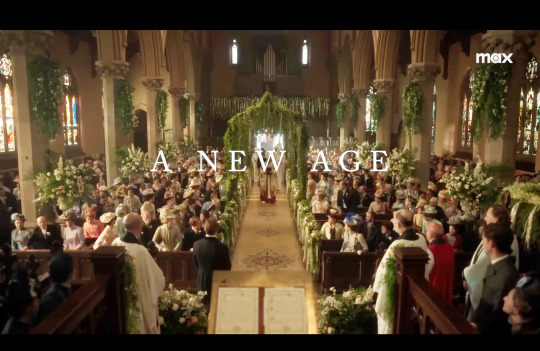
Alright, now we've got two images that I'm saying are definitely Gladys' wedding. In the front two rows of the wide shot you can see Bertha and then her sister behind her, with Bertha in the same outfit as the promo image. If you zoom all the way in on that wide shot you can see a man with a George-like beard at the front of the procession, presumably walking Gladys down the aisle with the bridesmaids behind her. Judging by the flowers and overall costumes, I think it's safe to say this is spring or summer. (I'm guessing 1884, but I guess we could have a very long engagement if the Duke has other plot and has to go back to England or something and which would make this 1885.)
Two other sets of scenes worth noting.
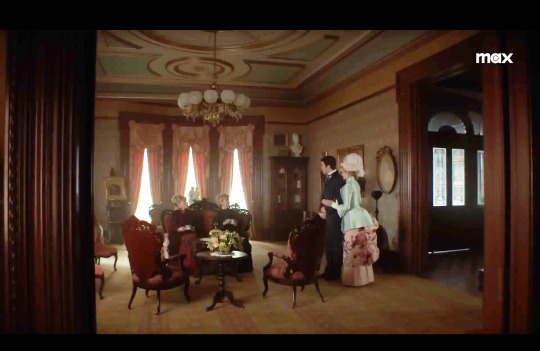
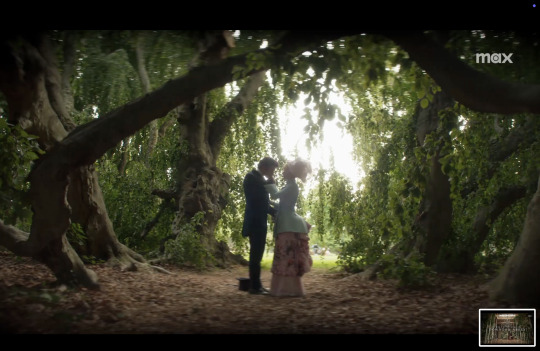
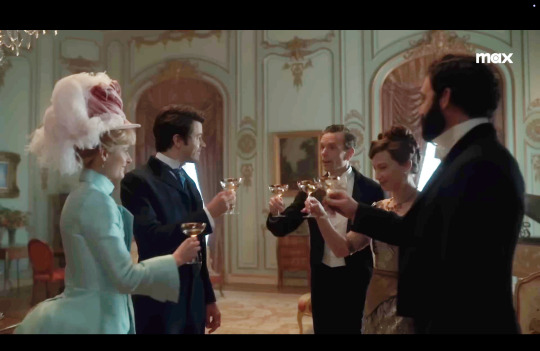
Here we have Marian in her "twirling in the gardens with Larry" dress with both of then talking to Agnes with her rebellion line and what appears to be the Russells toasting Larry or Larry and Marian. This could be spring/summer of 1884 or 1885, depending on which comes first, Gladys' marriage or more of them courting (or all at once). Notably that looks like the new character, Alfred Merrick with the Russells, who they invite over in hopes of charming for some business deal (for Larry and Jack? or for George's transcontinental railroad?).
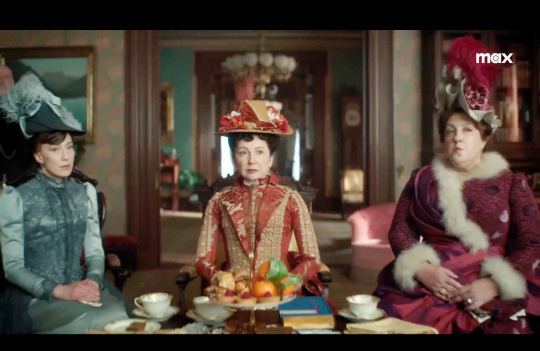
Finally, we've got all the faves in the Van Rhijn household looking cross, almost certainly at Ward McAllister. You can see his tell-all book in blue on the coffee table in front of Mrs. Astor (the label matches the image we get of the cover from other scenes.) Given Mrs. Fish's fur, I'm guessing this is winter, at least of 1884 but more likely 1885 or later. The actual book wasn't published until 1890 so unless we have a BIG time jump they're cheating here, but presumably Nathan Lane wants to peace out, so they're shifting things up a bit. This suggests the book timeline is later in the season.
58 notes
·
View notes
Note
Was it regular or at least seen as normal for the 29-year-old to propose to a 19 year old? If so until when was this common in England or British Isles I suppose?
The short answer is yes, completely normal, and it was normal until about the 80s. You can get a sense from this chart, which shows median age at first marriage in England and Wales:
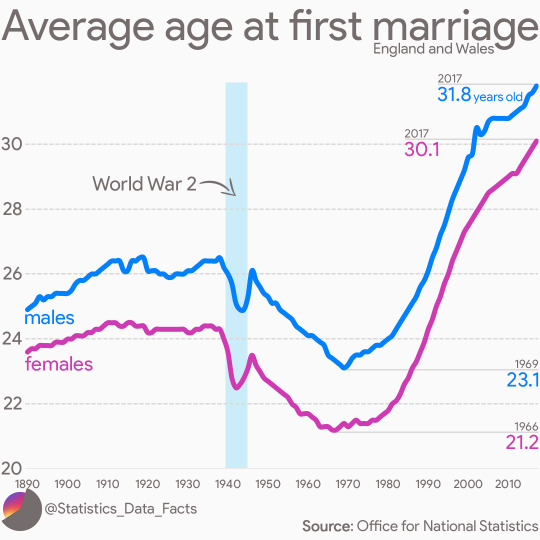
(from this blog, which also shows the same stats for the USA, where people have generally married a little younger and with a slightly larger age gap.)
Now I'm going to do a long answer under the cut because I find this subject fascinating. It ties into all kinds of questions, like who counts as an adult and what is marriage even for, where our answers have changed a lot and are still at least somewhat in flux.
In the 1890s, marriage was - in short - for starting a family. I mean, it was a lot more complicated than that, but this is a tumblr post not a book, so let's go with that. Couples in England did practise some element of family planning, which you can tell because the average fertility rate started falling from 1880 onwards (and I find it fascinating that this predates reliable contraception), but generally speaking it was a social expectation that women would not have sex outside of marriage, and if they did, they would get married on learning that they were pregnant.
The assumption that marriage = children was what informed acceptable ages for women to get married. Legally, boys could get married at 14 and girls at 12 provided that they had their parents' permission, but they very rarely did. It was widely recognised that early pregnancy was dangerous to girls' health - usually expressed as concern for their ability to bear children. That's where it was even possible, given that on average girls in the 1890s only started their periods at 17.
For example, the Lancet in 1883 published this about the ideal age for women to marry:
Prevention [of illness] is to be, in part, effected by avoidance of unions of immature women or of elderly women: in other words by securing that women are married at the age of nubility, or best age of marriage, with a view to fertility and the rearing of healthy children, and the safety of the mothers and this age is fairly well ascertained to be, for a population or mass of women, not under twenty and not above twenty five.
Obviously there were all sorts of other cultural pressures at play. A woman in Lucy's class, who would be expected not to work, was a cost to her family that they would ideally like to transfer to her husband. And a lot of the literature from this time assumes that young women will want to get married quickly; concerns about early marriage are often phrased around discouraging young women from being hasty, rather than the fear that their family will put them under pressure. Immaturity is raised as a concern, particularly from the perspective that young women might make unwise choices.
On the man's side of things, the important thing was being able to support a family. This was a little bit more complicated than we might imagine because a) some married women worked (about 40% of women were employed in the 1890s in Britain, about twice the rate of the USA), b) the work of wives in the household helped to save money, and c) after the age of 11 the kids could legally work too.
But generally speaking getting married was an expense that men needed to be able to afford, and more so the higher the class of the couple (because then both the wife and the children would be less likely to work).
That pushed men's first age at marriage older, and particularly so in higher classes where the expenses were greater. You can see that in this table from 1890:
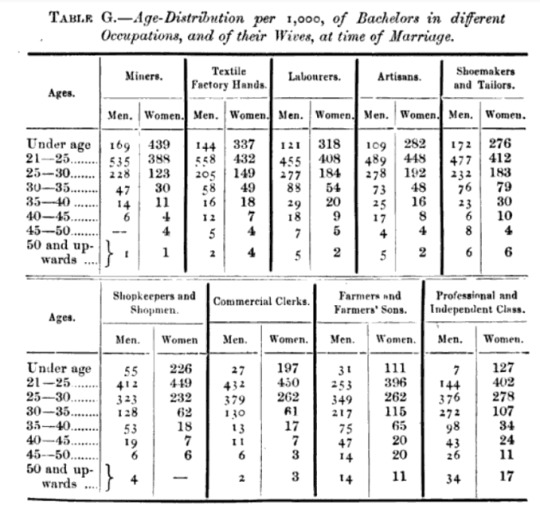
Every main character is in that final "professional and independent class" section, and we can see that the suitors are very typical in wanting to marry in their late 20s, whereas Lucy is a little more unusual, though not unheard of, in being under 21.
It's also interesting that first marriage is clustered in a relatively narrow age band. Most people had married by the time they were 35, though again there are slightly more older bachelors in the middle and upper classes. It's from the late 19th century that the "half your age plus seven" rule for age gaps starts to appear - sometimes as an ideal age gap, but sometimes used in the same way as today, where relationships with a greater age gap are described as inappropriate. And we can see from the stats that actually, the average age gap has barely changed.
I think it's really the same set of considerations that made first marriage so young in the 1960s. The economy was doing well, so men were able to support a family earlier in life, but the pressure to get married in order to have sex and start a family remained. And young women were generally in much better health than their 1890s predecessors so could have children at a younger age more safely.
OK, so what changed in the 1970s that meant that age at first marriage started going up? One thing is that having children out of wedlock became more normal so there was gradually less need for a hurried wedding if you found out you or your partner was pregnant:
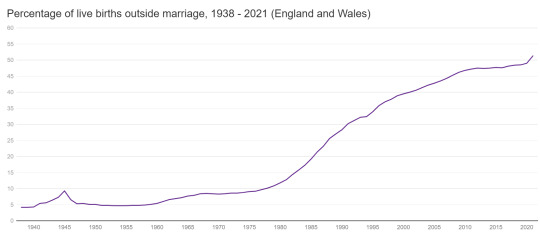
Reliable contraception (the pill was licensed for unmarried women in 1967) and access to abortion (decriminalised in England and Wales in 1967) also made it safer to have sex outside of marriage without the risk of pregnancy - so less need to get married in order to have sex.
Though the ultimate decoupling of sex and marriage in England and Wales only happened in 2023, when the age for legal marriage was raised to 18 (it had been 16 with parental consent) while the age of consent to sex remains at 16. The change happened quite quietly and the government was a bit embarrassed that they had allowed child marriage until then, but in some ways it was a significant step to say that actually, legally, sex can happen without marriage being an option.
Women's ability to work and to live independently is also a significant factor. Here's the female employment rate over time:

I would also expect the line to be a bit steeper if the ages covered were, say, 21 to 60 instead of 16 to 64, given a) the growing number of women in education from 16 to 21 who might not be working and b) comfortably-off professional women taking early retirement.
I can't find stats over the whole century for women's labour participation, but the milestone legislation of the Equal Pay Act in 1970 (which required equal pay between men and women for the same work) and the Sex Discrimination Act in 1975 (which made it unlawful to discriminate against individuals based on sex or marital status) significantly reduced the economic and social pressure on women to get married.
And of course in the modern day, it would be actively weird for Lucy to be getting married at 19. In England and Wales, of the 478,194 people marrying an opposite-sex partner in 2022, only 1,224 were under the age of 20 - 340 men and 884 women. That's 0.3%, and only marginally more than the percentage who were over 80.
59 notes
·
View notes
Text
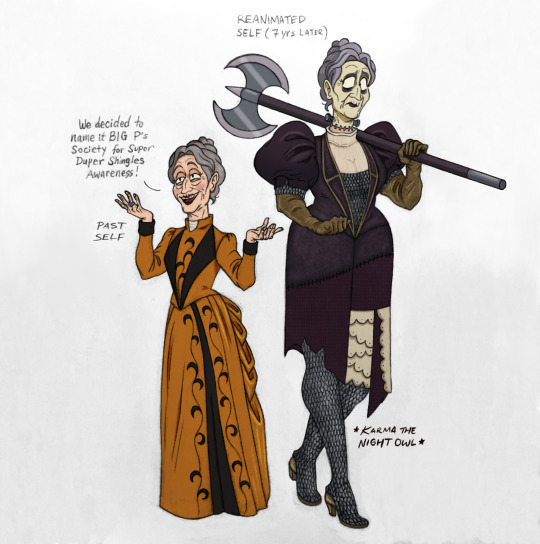
Here's how I imagine Lady Elizabeth Godwin when she was alive compared to her reanimated self. I was inspired by MANY different visual ideas and concepts like the original Frankenstein book, late 1880s strongwomen, and 1890s fashion.
Here was my aesthetic mood board!
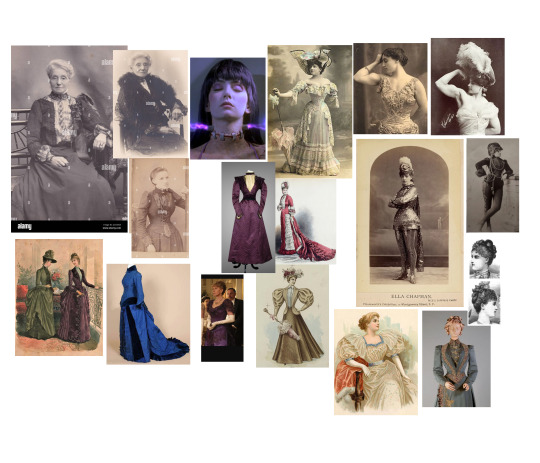
Since the og Frankenstein book describes the flesh of the creature to be yellow and translucent, rather than the popular green flesh seen in most film adaptations, I applied the former to Godwin's flesh of her head. Plus I wanted to really go for that corpse like appearance, particularly with the hollowness of her eyes.
The outfit she wore on the night of her passing was inspired by late 1880s bustle dresses. I saw that the og book of Bram Stoker's Dracula is set in an unspecified year of the mid 1890s, so I had an idea to make her reanimated self reflect the clothing/dresses of that era. Like having her upper part be a balloon sleeve dress with a blouse, and the lower part being a scarp of fabric from a late 1800s Balayeuse. I mentioned in my first character designs for the main pcs that when Godwin asked Igor for clothes, I imagined he made an outfit for her based on scraps he had in Frankenstein's lab. This also included chainmail above the blouse and under the dress coat based off of a Victorian Burlesque outfit. Godwin's gotta protect her new body somehow haha
This last part is just me rambling at this point but I thought this was fun to include. The two women flexing are Josephine Schauer Blatt aka Minerva, and Laverie Vallee aka Charmion (right). They were both strongwomen in the late 1880s, with Minerva having great talent in weightlifting and professional wrestling, while Charmion also performed in vaudeville trapeze. Just a fun little discovery I came across when looking up muscular build ideas for Godwin based on Justin's description :)
#also idk if this was intentional by Justin#but I find it funny how Godwin's demise parallels Elizabeth's from Frankenhooker just minus the hooker element#taz vs dracula#lady godwin#the adventure zone#taz versus dracula#nightowldraws#horror#character design#sketchbook#procreate
439 notes
·
View notes
Text

Discworld The setting of the comic fantasies by the novelist Terry Pratchett (b. 1948), a flat planet supported by four elephants riding through space on a giant turtle. There is no central character in the stories, although Death appears in each and is prominent in several. The first book in the sequence, The Colour of Magic (1983), was essentially a parody of H.P. Lovecraft (1890-1937) and other fantasy writers, but the series went on to create a world of its own, each of the volumes being self-contained. Much of the enjoyment of the stories derives from the strange names of characters and places, such as the wizard Igneous Cutwell, the kingdom of Djelibeybi, the Unseen Univesity situated in ANKH-MORPORK and Lady Sybil Olgivanna Ramkin, the latter's richest resident, married to Commander Samuel Vimes. See also RINCEWIND.
— Brewer's Dictionary of Phrase and Fable, 19th Edition (Susie Dent)
199 notes
·
View notes
Text
SSO timeline (REWORKED)
Consider the old timeline outdated! I’ve found new timestamps and made a few guesses based on character ages and relations to each other.
We have a few things to go off of: It’s been 20 years since Catherine died, and it’s been 45 years since the baroness left Mr Sands and Thomas was born. The old sisterhood, canonically all being born in 1977-1978, should be in their mid 40s. While I used to say Elizabeth’s age was a good jumping off-point, I think 47 is a bit too old considering the other people in her generation (like Sigry and Avalon). It would also make the gap between the failed sisterhood and Catherine’s death a bit too large.
So new theory! Sigry is 44 in the journals and probably born in 1977, and that is our reference point for the timestamps going forward. The journal ages are unreliable, but I’ll consider them canon unless contradicted by the games or books. In case of contradictions between different sso media, my canon hierarchy goes: Newer quests (Post-2018) > Books > Older quests > Journal ages > SSL.
I’ll put the source of my timeline claims in brackets. Confirmed, unmovable timestamps will be marked in green. Unclear time estimates will be marked with a ~. Let’s get into it!
1218
Jon Jarl arrives on Jorvik. [Starstable Online]
1702
Bertrude Silverglade passes away, leaving the Silverglade estate in the hands of an unnamed “mysterious relative”. [Starstable Online]
~1773
John Sandman and Rosalinda are born, ~25 years before Rosalinda’s death
1798
Rosalinda dies. She and John Sandman are engaged to be married, so they’re probably in their mid-20s. [The Legend Awakens]
1871
Mr Sanders fishes up a deep-sea creature, likely connected to Garnok. [Starshine Legacy]
1890
Owen D Sands establishes Deep Core Drilling Company on Jorvik. [Starshine Legacy]
~1890-1900
At some point during this time period, Mississippi Jones looks for the horn of Araxia. He is pursued by the presumed dead John Sandman. [Starstable Online]
1903
A cave-in/gas incident kills 211 workers and 14 civilians during a Deep Core drilling. (Sounds very similar to what happened in Old Hillcrest…theories…) [Starshine Legacy]
1904
Deep Core is forced to shut down. [Starshine Legacy]
1921
Beatrice, a soul rider of a former sisterhood, is born. She turns 100 years old in present day. [Ghost Stories from Jorvik]
1933
A former reincarnation of Starshine saves four girls who went missing on a school trip to a grave field north of Jorvik City. (Maybe this would be Beatrice’s eventual sisterhood?) [Starshine legacy]
1936
Annabelle Silverglade is born. [Starstable Online]
~1937-1940
Beatrice’s sisterhood is active.
~1949
Pi is born, most likely right inbetween Beatrice and Elizabeth.
1953
Esmeralda Holdsworth is born. [Starstable Online]
1954
Jasper Holbrook is born. [Starstable Online]
1959
John Sandman is on the Firgrove council. Herman Wetton is presumably born around this time, as he claims to have grown up in the 60s. [Starstable Online and Darkness Falling]
1964
Annabelle Silverglade marries John Sandman. [Starstable Online]
1965
Elsa Einstein is born. [Starstable ad]
~1965-1969
Pi is part of a soul rider sisterhood. [Aideen’s gift]
1970
Evergray is born. [Starstable Online]
1976
Annabelle Silverglade divorces John Sandman 45 years before present day. Thomas Moorland is born. [Starstable Online]
1977
Sigry Varanger and Caroline Westfall are born. [The Prisoner of Pandoria]
1978
Catherine Holbrook is born. [Starstable Online]
1979
Avalon is born. [Starstable Online]
1985
Dr Eiren Doyle is born. [Starstable Online]
1987
Ms. Drake is born. [Starstable Online]
1988
Rhiannon is born. [Starstable Online]
1989
Darko is born. [Starstable ad]
1995
Elizabeth arrives on Jorvik. She, Eva, Sigry and Caroline form a soul rider sisterhood. [Shadows Over Jorvik]
~1996
Catherine joins the sisterhood, but grows distant after a failed light ride. [Starstable Online]
~1997
Caroline goes missing and is never seen again. [Starstable Online]
~1999
Catherine’s horse dies after being part of a dangerous ritual. Evergray is presumably banished shortly thereafter. [Starstable Online]
~2000
Catherine and Thomas get married. Josh B’gosh is born. [Starstable Online, Starstable ad]
2001
Catherine dies. Justin is born. [Starstable Online]
2002
Rania Varanger is born. [Starstable Online]
2003
Linda Chanda, Alex Cloudmill, Lisa Peterson and Anne von Blyssen are born in the same year. Derek, Maya, Tan and Loretta are also born this year. [Starstable Online, Jorvik Calling, Starstable ad]
2010
Madison Hightower is born. [Starstable Online]
2011
Rhiannon arrives on Jorvik, ten years before the beginning of SSO. [Starstable Online]
2019
Lisa Peterson arrives on Jorvik, two years before the beginning of SSO. [Starstable Online]
2021-2022
Main story of Starstable Online.
67 notes
·
View notes
Note
I'd love to know your thoughts on the Gaunts in Hogwarts Legacy. I loved Ominis as a character, and the story of his family was interesting, but I'd really love an in-universe explanation for how they get to the state they are at when Tom is born in less than what... 40ish years? At most? How exactly do they go from multiple family members functional enough to attend Hogwarts to barely able to speak English (or seemingly use magic) that quickly?
So, the reason I didn't put Ominis and the Gaunts in my big canon contradictions in the HL post, is becouse I can in fact headcanon my way into Ominis' existence making sense (kinda). We only need one big factor that would allow for a very fast decline and we have one — inbreeding.
I mentioned this already here, but Marvolo speaks like he remembers the influence his family once had. Not only that, but he's different from his kids. He acts more like a person who can be somewhat reasoned with than both his barely more than squib children who don't seem capable of much intellectually.
How this might've happened is, say, one Gaunt got obsessed with blood purity and around the 1780s married his cousin.
His children turn out okay since it's just one generation of cousin marriages, but then his son also marries a cousin in the 1810s.
Their children would still seem reasonably fine and marry cousins again. And they have children in the 1840s.
By this point, most of them would be losing prestige and money and many other purebloods would want nothing to do with the Gaunts. This pushes them to keep marrying just a bit too close and shrink down the family to only the main line and maybe another one.
So, these children born in the 1840s would have their own kids with their cousins around the 1870s.
Now, these kids are Marvolo and Ominis, another brother (since Ominis mentions having older brothers), and at least one sister (for the sake of this theory to work). By this point, inbreeding would start to be a problem after 4 generations of first/second-cousin marriages in a row, which would work with Ominis being born blind, for example (which is a possible result of inbreeding).
Now, while both Ominis in the game and Marvolo in the 1920s talk a big game about their family influence, by the 1890s, it's a lie. I think they started falling from grace earlier throughout the century (as I mentioned), losing money and prestige and holding onto their position in the wizarding world by the skin of their teeth. Ominis' posturing about his father knowing the headmaster in HL always came off to me as just that — posturing. His father may have met Phineas Nigellus Black, but they weren't close by any means. Ominis is just threatening you the way he knows and can — which is some of the connections still left for his family since the money ran dry years ago.
The fact we don't see other kids in Slytherin trying to win Ominis' good graces for the sake of his family's influence (blindness or not) again suggests a lot of said influence is posturing more than the real deal. I mean, he's only friends with Sebastian and Anne, two students who are definitely outsiders within Slytherin (even if there's no way they live in Feldcroft, since there's no way that hamlet doesn't exist in the books).
Also, Ominis mentions his brothers and father tortured muggles. There's a non-zero chance that in 1890 most of his family is in Azkaban and he really is just lying and he has nothing he can do against anyone with his connections. Basically, it's a bluff.
I think seeing them like this adds an interesting reason as to why Noctua (Ominis' aunt) would want to look for Slytherin's Scripturium (though I don't think the Scripturium exists in the books, so let's say she looked for the Chamber of Secrets and was eaten by the basilisk since she wasn't the heir it was meant to obey in the 1880s). Becouse she's trying to bring the family back to its place of influence as descendants of Salazar Slytherin in a different way from her brother.
By the 1890s, Noctua is dead, there are no Gaunt cousins, just the main line with Marvolo, Ominis, unnamed brother, and unnamed sister.
Ominis is likely disowned at some point, and it fits his character to decide not to have kids and not pass on Parseltongue, which he sees as dark. I can see his character making that decision. But for this theory to work, he has to die before Tom is born, so he doesn't live a long life unless he left Britain and is living happily in the US or Australia or something.
The unnamed brother might be in Azkaban for crucio-ing a muggle, getting him out of the picture in an in-character way and making sure he has no kids.
Marvolo is where it gets interesting becouse with the state we see with his kids, and the nosedive off a cliff the family took in his time, my theory is that he had his kids with the aforementioned named sister. It would explain why Morfin and Mereope are like that. It would explain why they were completely shunned from wizarding society. How they lost even the measly amount of influence they had so quickly. It would fit with Marvolo's view of blood purity and the Gaunts' blood in particular, being purer than the rest.
So, this is my answer as to how I can headcanon my way into the Gaunt family's fast decline making sense. That being said, do I think Ominis is canon for the books' universe? Probably not, but I can make up shit to make it work, as I illustrated here.
#harry potter#hp#hp meta#hollowedtheory#asks#anonymous#harry potter meta#wizarding world#gaunt family#house of gaunt#ominis gaunt#marvolo gaunt#hogwarts legacy
95 notes
·
View notes
Text
tracking down a fresco for fun and profit*
in my ongoing reposting of my entire painting tag, i reached this image:
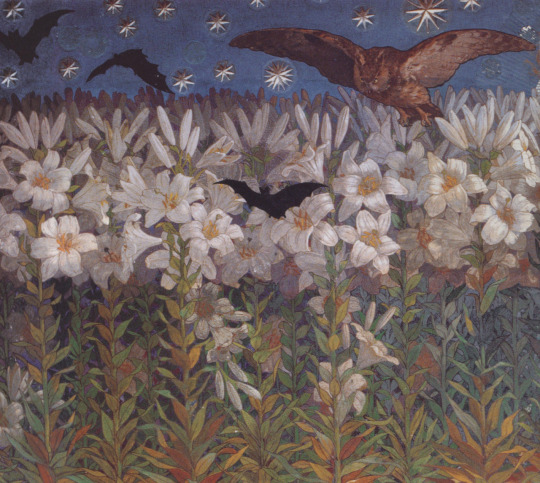
lovely painting. clear why i reblogged it in 2020. the caption is as follows: "Achille Casanova, The Night (detail), 1894-1897"
whenever i see something described as a detail, i like to look up the full image. for context, and for fun (this is all very fun for me). so i did that here, and found that everything that came up in relation to this image, artist, and title was only this detail specifically. next, i went to the source of the tumblr post, and found that it was a flickr post from a since-deleted user. searching for the artist and title brought me to this instagram post, which mentions the Palazzo Ratta-Pizzardi in Bologna and we were off to the races.
i had a false start in bologna, as i didn't realize that there are multiple palazzo pizzardis in bologna. then naturally i got sidetracked by the Palazzo Rosso, with its gorgeous Zodiac Room.

these frescoes are attributed to Augusto Sezanne, but those in the stairwell are thought to be by our guy Casanova.

anyway, once i got myself into the correct palazzo, i finally found the fresco:
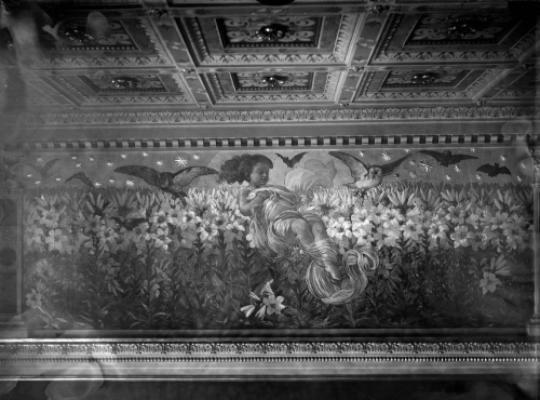
good to know i'm in the right place, but that's not the image i want. (although still a very cool find--it was taken by Pietro Poppi, whose archive dates it to c. 1897, when the frescoes were completed.) i started playing around with various wordings in searches and got myself onto this page, with its very small image of what i was sure was the room with Casanova's frescoes. i plugged it into tineye and got the original, slightly larger version of it:
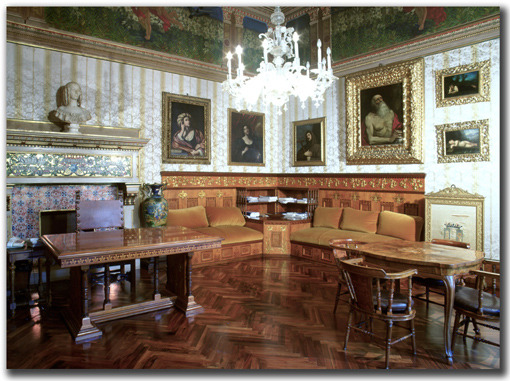
(important to note that i spent an hour or so trying to access sources from a list i found, hoping there would perhaps be a pdf or even print book with better images in them. and there may be, but none that i could get to from my desk at work.)
i kept at it, and eventually found a pdf about the various pizzardi buildings, including an image of this room with--miracle of miracles--a photographer's name (A. Samaritani). i searched for that, plus bologna, plus fotografia, and found him. poked around on his website and finally FINALLY! i had color photos of the owl bat fresco.
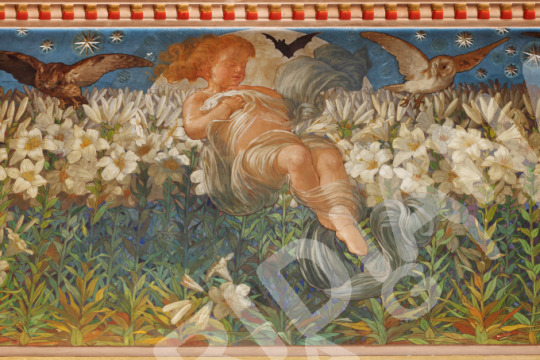
and that's the end of my journey. i didn't find a large image that i could share (aside from the watermarked ones i included here), but that's genuinely a-ok because i had a really good time and also learned a LOT about late 19th/early 20th century italian dec arts, which i didn't even realize was a blind spot for me. over and over, i saw Casanova's frescoes referred to as "Liberty" style, which is soooooo cool because i'd put money on it deriving from Liberty's London. (edit: im right)
Liberty's is a department store which had a very strong British Arts & Craft aesthetic primarily due to the design leadership of Archibald Knox in the 1890s. i doubt that it was known as liberty style at the time--most of the terms we know art movements by were applied decades if not centuries later--but it's still such an interesting connection to me. in part because none of the liberty buildings and frescoes i've looked at today looked particularly "Liberty London." Aesthetic Movement and Art Nouveau, yes, but Knox and Liberty's had a very strong, distinctive style, and Stile Liberty isn't it.
and speaking of distinctive styles--Bologna has one. the specific vernacular of stile liberty for bologna (and the wider emilia-romagna region) is referred to as "Æmilia Ars," taken from the applied arts society founded by Alfonso Rubbiani of the same name (much like William Morris did in England). the society lasted only 5 years, but the textile arm stayed together longer and was present at several decorative arts fairs in the first decade of the 20th century, including the exposition in St. Louis, Missouri, USA.
the palazzo ratta is now part of the municipal health network, so while i do think it's possible to visit and see these frescoes, it's primarily a building with a job (local health authority). but i know a lot more about the bats and owls and the context in which they were made now, and maybe you do too.
* absolutely zero profit will occur
53 notes
·
View notes